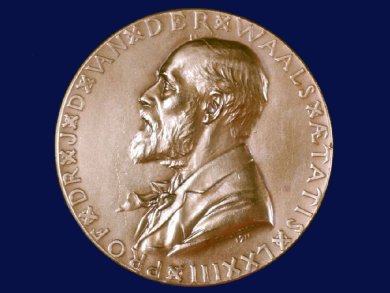The Nobel Prize in Physiology or Medicine 2013 has been awarded to
- James E. Rothman, Yale University, New Haven, CT, USA,
- Randy W. Schekman, University of California, Berkeley, CA, USA, and
- Thomas C. Südhof, Stanford University, Stanford, CA, USA,
“for their discoveries of machinery regulating vesicle traffic, a major transport system in our cells”.
James E. Rothman, born 1950 in Haverhill, MA, USA, studied physics at Yale College, USA, and graduated in 1971. He obtained his Ph.D. in biological chemistry from Harvard Medical School, USA, in 1976. After completing a fellowship in the Department of Biology at the Massachusetts Institute of Technology (MIT), USA, in 1978 he joined the Department of Biochemistry at Stanford University as a professor. He remained there until 1988, when he took the E. R. Squibb Professorship of Molecular Biology at Princeton University, USA. In 1991 he founded and chaired the Department of Cellular Biochemistry and Biophysics at Memorial Sloan-Kettering Cancer Center, New York, USA, where he held the Paul A. Marks Chair and served as Vice-Chairman of Sloan-Kettering till 2004.
Rothman is currently the Wallace Professor of the Biomedical Sciences at Yale University and Chairman of the Department of Cell Biology, Yale School of Medicine, and is the director and founder of the Nanobiology Institute at Yale.
James Rothman used a biochemical approach to investigate the molecular basis behind vesicle formation, cargo selection, and movement to the correct organelle or path outside the cell.
Randy W. Schekman, born 1948 in St. Paul, MN, USA, studied molecular biology at the University of California, Los Angeles, USA. In 1975, he received his Ph.D. in biochemistry at Stanford University, USA, under the supervision of Nobel Laureate Arthur Kornberg. He then worked as a postdoctoral fellow with John Signer, who was investigating the outer membranes of mammalian cells. In 1976, he moved to the University of California, Berkeley, USA, to take a position as an independent researcher.
Currently, Schekman is a Professor of Molecular and Cell Biology at the University of California and also an investigator at the Howard Hughes Medical Institute, USA.
Randy Schekman discovered a set of genes that were required for vesicle traffic.
Thomas C. Südhof, born 1955 in Göttingen, Germany, studied medicine at the University of Aachen, Germany, Harvard, USA, and the University of Göttingen, Germany. In 1982, he gained his doctoral thesis on the structure and function of chromaffin cells, from the Max Planck Institute for Biophysical Chemistry in the lab of Victor P. Whittaker. Südhof moved on to a postdoctoral position in the department of molecular genetics, University of Texas Health Science Center (now the UT Southwestern Medical Center), Dallas, TX, USA, under the supervision of Michael Stuart Brown and Joseph L. Goldstein. Here he worked to describe the role of the LDL receptor in cholesterol metabolism, for which Brown and Goldstein were awarded the Nobel Prize in Physiology or Medicine in 1985. In 1986, Südhof was made an investigator of the Howard Hughes Medical Institute. He was also given his own laboratory at UT Southwestern Medical Center where he focused on the presynaptic neuron for over 20 years.
In 2008, Südhof moved to Stanford University and is currently the Avram Goldstein Professor in the School of Medicine as well as a Professor of Molecular & Cellular Physiology, Psychiatry, and Neurology.
Thomas Südhof is best known for his research into the presynaptic neuron. His findings have provided a lot of our current scientific understanding of presynaptic neuron behavior in neurotransmission and synapse formation.
Publications
R. E. Rothman
- The protein machinery of vesicle budding and fusion,

James E. Rothman,
Protein Sci. 1996, 5 (2), 185–194.
DOI: 10.1002/pro.5560050201 - Membrane assembly: Synthesis and intracellular processing of the vesicular stomatitis viral glycoprotein,

Flora N. Katz, James E. Rothman, David M. Knipe, Harvey F. Lodish,
J. Supramolec. Struc. 2004,7 (3-4), 353–370.
DOI: 10.1002/jss.400070308 - Conformational change of chaperone Hsc70 upon binding to a decapeptide: A circular dichroism study,

Kyusung Park, Gerald D. Fasman, Gregory C. Flynn, James E. Rothman,
Protein Sci. 1993,2 (3), 325–330.
DOI: 10.1002/pro.5560020304
T. C. Südhof
- Region-specific deletions of RIM1 reproduce a subset of global RIM1α−/− phenotypes,

M. E. Haws, P. S. Kaeser, D. L. Jarvis, T. C. Südhof, C. M. Powell
Genes, Brain and Behavior 2012, 11 (2), 201–213.
DOI: 10.1111/j.1601-183X.2011.00755.x - Cerebellins meet neurexins (Commentary on Matsuda & Yuzaki),

David C. Martinelli, Thomas C. Südhof
Europ. J. Neurosci. 2011, 33 (8), 1445–1446.
DOI: 10.1111/j.1460-9568.2011.07665.x - Rab3 Proteins Involved in Vesicle Biogenesis and Priming in Embryonic Mouse Chromaffin Cells,

Jean-Sébastien Schonn, Jan R. T. Van Weering, Ralf Mohrmann, Oliver M. Schlüter, Thomas C. Südhof, Heidi De Wit, Matthijs Verhage, Jakob B. Sørensen,
Traffic 2010, 11 (11), 1415–1428.
DOI: 10.1111/j.1600-0854.2010.01107.x
The full range of Professor Südhof’s work published by Wiley can be found on Wiley Online Library.
R. Schekman
- Molecular machinery required for protein transport from the endoplasmic reticulum to the golgi complex,

Linda Hicke, Randy Schekman,
BioEssays 1990, 12 (6), 253–258.
DOI: 10.1002/bies.950120602
Also of interest:
- Nobel Prize in Chemistry 2013
Martin Karplus, Michael Levitt, and Arieh Warshel, all USA, were awarded - Nobel Prize in Physics 2013
Francois Englert, University Libre de Bruxelles, and Peter W. Higgs, University of Edinburgh, have been awarded - Nobel Peace Prize 2013
The Organization for the Prohibition of Chemical Weapons has been awarded for its extensive efforts to eliminate chemical weapons




